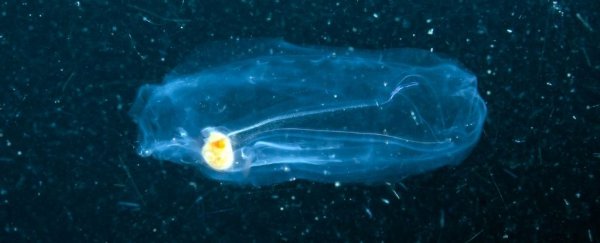Sweeping the ocean floor at hundreds of points throughout the world, researchers have revealed an astonishing diversity of microscopic life thriving in the deepest and darkest parts of our planet.
The sediment collected at each spot was analyzed for environmental DNA (eDNA), which marine animals shed as they go about their lives. While sea creatures cast off some of that eDNA, among that material is also evidence of microbes and other tiny animals that make up the shadowy ecosystem at the bottom of the world.
Researchers compared the results to other existing DNA datasets of plankton, collected in the upper layers of the ocean, to make sure they only identified creatures of the deep.
In the end, the researchers found most eukaryotic organisms living on the ocean floor are unknown to modern science. What's more, it looks as though the ocean's abyss is home to at least three times the diversity of microbial life as the waters above.
It's the first time scientists have put together a consistent molecular dataset of the ocean realm on a such global scale, and while the meta-analysis isn't comprehensive, it's an impressive start.
"We compared our deep-sea benthic DNA sequences to all reference sequences available for known eukaryotes," says geneticist Jan Pawlowski from the University of Geneva in Switzerland.
"Our data indicates that nearly two-third[s] of this benthic diversity cannot be assigned to any known group, revealing a major gap in our knowledge of marine biodiversity."
The deep ocean's sediment covers more than half the surface of our planet, but the vastness of this habitat – not to mention its difficulty to get to – means we have virtually no idea what's going on down there.
In recent years, remotely operated vehicles have helped us explore a minuscule fraction of the deep sea. Yet, even those brief brushes with the benthic community showed us a whole new world.
So even though the ocean floor looks seemingly isolated, it doesn't take much to coax a huge abundance of life out of the darkness.
The current analysis mostly looked for smaller-sized organisms, like diatoms and dinoflagellates, and tiny animals, like worms and small molluscs. The diversity of plankton found matches other evidence suggesting the deep sea is also home to a diversity of larger animals.
The tiniest creatures, however, are often the glue that holds food webs together. They are also critical regulators of the global climate, helping to bury carbon in the deep ocean.
"These deep-ocean sediment assemblages comprise not only taxa that are known to be important drivers of the biological carbon pump but also several taxonomic and functional groups that have been overlooked in what is arguably one of the most fundamental ecological processes of the world ocean," the authors write.
"Together, our results highlight the [deep ocean sediment] as one of Earth's richest modern ecosystems and fossil archives."
Recent evidence, for example, has found deep-sea plankton can be preserved in sediment just below the seafloor. This leaves open the possibility that we can compare benthic life forms today to life forms of the distant past, to see how these deep-sea communities are faring in a rapidly changing world.
Given how much life is at stake, the authors are calling for further exploration of the seafloor to understand better and protect these deep-sea ecosystems. That's especially important now that commercial deep-sea mining is on track to proceed in the next few years, despite repeated warnings from marine scientists that we need extensive ecological risk assessments first.
"With nearly 1,700 samples and 2 billion DNA sequences from the surface to the deep-ocean floor worldwide, high-throughput environmental genomics vastly expands our capacity to study and understand deep-sea biodiversity, its connection to the water masses above and to the global carbon cycle," says Tristan Cordier from the Norwegian Research Center and the Bjerknes Center for Climate Research.
The more we learn about the deep ocean, the more it seems like a habitat worth protecting.
The study was published in Science Advances.
